#Sacred altar of Mayan religion
Explore tagged Tumblr posts
Text
Batlings (D&D Homebrew Race 5e) LORE part 2
I ran out of pictures :( so here's a gif.

Mythology & Religion.
The mythology of the Batlings is heavily inspired from christian mythology and Aztec and Mayan Myth. Is similar to catholicism with a splash of blood sacrifice.
Their Creation Myth is that their God, an entity known only as “The Lord”, “our Lord” or “The Lord Almighty” created all things by flaying himself alive and giving his heart blood to the batlings to drink inorder for them to gain the knowledge on how to worship him.
In their eyes he gave them sentience and sapience and thus the ability to experience free will. That is why Batlings value freedom so much, they view it as a gift from god.
(Note: In actuality the batlings were created by a wizard. Like the Kuo-Toa their sustained belief in the misinterpretation of the wizard who created them as a God eventually elevated the manifestation to Godhood.)
(Batling God Stats.
Name: The Lord Almighty.
Alignment: (LN) Lawful Neutral.
Provinces: Creation, Life & Death, The Sun.
Domains: Order, Grave, Light, Forge.)
Batling Religious Rites.
1: The Rite of Scripture.
(Prayers are to be said in the churches, if not then they are to be said at personal altars or with holy symbols in hand. written prayers are to be written in blood.)
2: The Rite of Hymns.
(Songs of praise are to be sung in churches with the community or with family).
3: The Right of Blood.
(Blood is to be drunk and cookies/biscuits to be eaten during mass to represent the symbolic sacrifice of flesh and blood of the lord)
4: The Right of the Banquet.
(On occasion a feast is to be held in honor of the lord, all participants must bring food or give grace at the meal)
5: The Right of the Dance.
(On occasion a dance is to be held in honor of the lord)
6: The Right of Sacrifice.
(On occasion a prized cattle is to be selected, sacrificed by way of having its heart cut out and rolled down the steps of the church in honor of the lord to symbolize his honorable sacrifice of his blood. the cattle is then eaten by the church goers and clergy)
Sanitification.
If a Batling that has lived a particularly pious or pure life devoted to the clergy they will sometimes be declared a saint.
When they die their body is stripped of skin in one clean sheet so that it can be made into an Ibbil (batling holy text), next the flesh and organs are taken and preserved into small reliquaries so that they could be given out to the people and clergy. Lastly the bones are tended to in a sacred ritual.
1: They are washed in holy water and lakered in holy oil.
2: They are then painted solid black and gilded with gold and gems (some are carved with passages of the holy Ibbil in them).
3: They are arranged in a holy pose and placed within the church.
The Illbil.
The Batling Holy scripture known only as “The Holy Ibbil” is a large tome consisting of 26 books all written by 16 paladins of the Lord Almighty's demigod son “Dioes Aceite”.
The first of the books are focused on stories of their God and history.
The second set of 8 books are focused on stories of saints and their lives.
The other 13 books are about the son of their god Dioes’s adventure until his self-sacrifice to end the summoning of “Old Scratch” the devil they fear.
The last book in the Batling Ibbil is about how their god will return to them in a great light of fire.
1 note
·
View note
Text
The Heart to Heart Spirituality of the Mayans
The creation of a sacred altar by a Mayan village or other form of community can occur at any time. Its intention among many is to facilitate healing and reconciliation among members of the group; it is a basic spiritual practice of the Mayan religion.
The practice and significance of a Mayan community creating a sacred altar is described in what follows. It is based on a handout provided visitors to the Institute of Intercultural Studies and Research (INESIN) in San Cristobal de las Casas, Chiapas, Mexico. All quotations are from the handout written by the Institute’s Mayan staff members. “The altar begins to take shape as the community…

View On WordPress
3 notes
·
View notes
Text
Incense Correspondence Table

Written and Compiled by George Knowles
Incense has long had associations with magick and witchcraft, as indeed it is used commonly by many other religions. The use of Incense in witchcraft is threefold:
(1) It conditions the mind by stimulating our senses of smell.
(2) In connection with spells, it draws down the spirits through it's magickal association with the elements of Air.
(3) According to ancient beliefs, when a spell is done. It raises the spell up into the ether and sends it on it's way.
In magick, the type of incense used needs to correspond with the nature of the spell being worked. Most spells require an incense associated with a particular planet or deity. Many are used for their purification and cleansing properties during ritual.
Below is a list of commonly used incenses and their corresponding associations. For other associations and correspondences see:
Blue Berry - Burn this to keep unwanted influences away from your home and property.
Blue Roses - Is specially crafted to honour the Goddess in all her aspects.
Carnations - This is a sweet floral scent traditionally used for healing.
Cherry - Is sacred to Venus, this blend will attract and stimulate love.
Cinnamon -Is used to gain wealth and success.
Coconut - Burn this for protection and purification.
Copal - Is sacred to the Mayan and Aztecs, this blend is suitable for honoring the Gods.
Frangipani - Burn this to brighten your home with friendship and love.
Frankincense - Use this to draw upon the energy of the sun to create sacred space, consecrate objects, and stimulate positive vibrations.
Honeysuckle - Burn this for good health, luck, and psychic power.
Jasmine - Is used for luck in general, especially in matters relating to love.
Lotus - Is used for inner peace and outer harmony, to aid in meditation and open the mind's eye.
Musk - Burn this for courage and vitality, or to heighten sensual passion.
Myrrh - This is ancient incense for protection, healing, purification and spirituality.
Passionflower - Is used for peace of mind, this sweet scent will soothe troubles and aid in sleep problems.
Patchouli - Is an earthy scent used in money and attraction spells.
Pine - Burn this for strength, and to reverse negative energies.
Rose - Is used for love magic, and to return calm energies to the home.
Sandalwood - Is a delicious all-purpose scent used to heal and protect, also for purification.
Spice - Is a fiery scent and used for any magic workings.
Spirit - Use this to raise your personal vibration, attract spirit guides and honour your personal deity.
Strawberry - Is used for love, luck and friendship.
Tangerine - A solar aroma used to attract prosperity.
Temple - Devotional incense used on the altar during ritual.
Vanilla - Is used to stimulate amorous appetites and enhance memory.
https://www.controverscial.com/Incense%20Correspondence%20Table.htm
7 notes
·
View notes
Text
Guatemala: Settling In
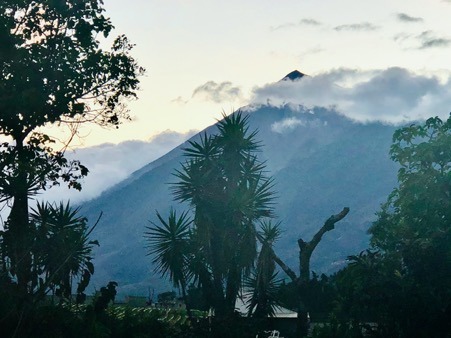
Above: The stunning view from my host family’s roof.
Arrival & Orientation: Thursday, March 5 - Sunday, March 8
I never really fell into a deep sleep before the alarm sounded at 2:45am on Thursday. Four adrenaline-boosted seminarians loaded the van and headed to Baltimore airport for a 7am flight: Luke, Emily, Abby C. and me. A delayed take-off made an already tight connection in Atlanta tighter but seeing our heroic sprint, the gate attendant waved us on, unlocking the door and allowing us to sneak on. I was thankful (and utterly surprised) that I managed to pack all carry-on, as the group’s luggage had not been as successful dashing from plane to plane. Abby C’s fiancé, Hans, met up with us; making us a complete group of 5 entering Guatemala. David Hope-Tringali, one half of our in-country coordinator team, met us at the airport with a bearded smile and banana bread, both equally warm and inviting.
The rest of the day was a sleep-deprived blur: Guatemala City traffic breaking free to steep mountains, Spanish voices calling, Jennifer Hope-Tringali waving from their front door in Antigua, her other arm cradling one-month old daughter, Maeve. After a needed lunch and quick meeting, we met our host families in the residential, working class town of Ciudad Vieja, just a few minutes outside Antigua. My host is Mildred, a kind young woman who lives in a simple home with an incredible view. She welcomes me in, feeds me well, and kindly directs me to bed.
The next few days are about finding initial orientation and context in this new place. Friday, we met early for a walking tour of Antigua city. The former capital now tourist hub boasts much history in less than one square mile. With a large group of fanny pack sporting “gringos” (non-locals), we learned politics in city hall, religion in the old cathedral, Mayan heritage in the jade museum, and culture through various galleries and exhibits, often tucked inside old hotels. The afternoon brought an informal walking tour of Ciudad Vieja, exploring our own neighborhood and practicing our residual high-school Spanish vocabulary.
Saturday, we traversed the mountains to the Iximche Mayan ruins. The Maya-Kaqchikel people settled Iximche in 1470 as a capital city and home to 400 residents. Today, many of its 170 building are partially preserved, including temples, pyramids, altars, residential and administrative palaces. Mayan people still make up 60% of the Guatemalan population and a local group was present conducting a traditional ceremony on the still sacred grounds. In the afternoon, we debriefed and connected over beers and tacos at Cervezeria Catorce, a local craft brewery. I must admit; in a swell of newness, foreign language and friendly strangers, it was a grounding comfort to take a seat in a setting that felt so familiar.
Today, we attended an English-speaking service at St. Alban’s Episcopal Church and wandered Antigua. It is perhaps the most beautiful city I’ve ever been in: cobble-stone streets weaving around brightly painted homes, three volcanoes protruding from the green earth in the background. I walk around in a constant state of awe and gratitude. There are so many unknowns and firsts – not just because this is a pilot program for ULS – but I am happy to jump into them and deeply thankful for the privilege to do so.
1 note
·
View note
Text
Well Shit: The Elvhen Ritual (Part 4 of 4)
We have examined why the Well of Sorrows was so important to the ancient elvhen Sentinels, the origins of the Vir’abelasan, and whether Dirthamen’s Temple once contained a Well as well.
If our theory that the Well of Sorrows is more than a plot device for Inquisition, and that it and many other important story elements for the rest of the Dragon Age series were previewed in earlier games, then it stands to reason there should be something like the Well of Sorrows in Origins or DA2. And it is there.
In fact, most of our Wardens drank from the Well, which could lead to a “Well, shit!” moment for the Warden if they are still alive (and make an [unlikely] appearance) in DA4.
The ruins in the Brecilian Forest are extremely interesting. There are so many important details in them that they could be a series of posts unto themselves. They, and the ruins in the Dalish Origin, point to elves and humans living together side by side after the Veil was created for hundreds of years before Tevinter shows up.
The Wiki says that the Brecilian Forest ruins are probably Tevinter in origin, but honestly that seems highly unlikely given what we find in them and the history we learn from the elf trapped in the spirit crystal. There are signs that indicate these ruins once used eluvians as doors in some places and the presence of what is almost certainly a Well of Sorrows.

Before we get into the details of who created this well, let's first examine if it is actually a Vir’abelasan. There are many indications that the “fountain” in the depths of the temple was used to prepare the honored elven elders for uthenera, just like the Well of Sorrows. When you pick up the tablet that starts the Elven Ritual quest you get a message that says:
“Most of the carvings are faded. What little you can make out involves a scene where the honored dead is laid to rest inside a grand chamber.
There seems to be some kind of process involving the altar before the body can be laid to rest, but most of those runes are illegible.”
The text could be interpreted as a funerary ceremony, but when you read the codex entry for the tablet, it details a process that seems very similar to the ritual that occurred when servants of Mythal placed their memories and knowledge in the Vir’abelasan before entering uthenera.
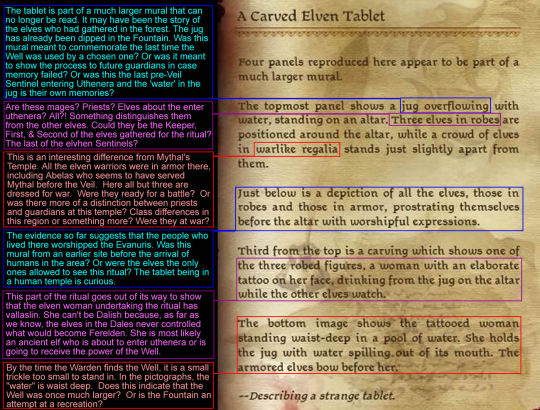
A Warden who didn’t know anything about the Vir’abelasan would, of course, have interpreted these scenes as some sort of cleansing ritual, but post Inquisition the image of an elf with vallaslin standing in a pool pouring something into the ‘water’ while being revered by other elves takes on another meaning.
There are differences, of course. There doesn’t seem to be an altar near the Well in Mythal’s Temple, and the “Well” is very small. The Warden doesn’t seem to gain any great insights or whispers that help them understand the ancient mysteries. Problematic, but not necessarily a sign that it was not a Well. So what else do we have?
There are some other indications that there is a “will” or force influencing the actions of people who come in contact with the Brecilian Well/Fountain. In the text describing the Warden’s thoughts and actions while interacting with the Fountain and altar are very interesting:
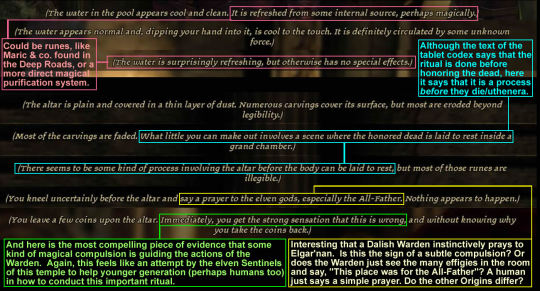
Some force or intelligence subtly prompts the warden away from ‘common’ mistakes, like leaving an offering. It is interesting that small mistakes such as the offering are acceptable, but once the clay jug becomes involved shades punish those who do the ritual wrong. It is interesting that shades attack the warden if they drink all of the water from the jug, leaving nothing to pour back into the fountain. These shades can be defeated with relative ease, but it is a stern reminder to do the ritual correctly.
The warden can still finish the ritual correctly even after the shades attack them, which again suggests that this ritual was supposed to be idiot proof. It was more important to the creators of the ritual that it be finished than it was for it to be done correctly the first time. This suggests that they expected the people performing the ritual to not know the proper forms of the ritual and that they might need a second chance. This is suggestive and we will circle back to this idea in just a moment.
This may not be conclusive proof that this Fountain is a Well of Sorrows, but the totality of the evidence is certainly pointing that way. The images inscribed on the tablet alone make it more than likely that the elves who once lived in the ruins knew about the ritual performed in Mythal’s Temple. Now we have a few other questions to answer: Is this an original Well of Sorrows? A remnant that was revived by later generations of elves? Or was it a recreation of a Well by elves who were not clear about exactly how to do the ritual?
Option 1: The Fountain is an original Well of Sorrows.
Given the number of differences that exist between the ritual we see in Inquisition and the images shown on the tablet it seems unlikely that the Brecilian Forest Well is an original. The elven mage who trapped his own spirit in a crystal just before the temple (and presumably it’s inhabitants) was destroyed, said that the ruins were built by humans, not elves. These two facts together make it very unlikely that the Well is one of the originals dedicated to preserving the Sentinel’s knowledge.
Option 2: The Fountain is a remnant of an earlier Well that was revived by later generations of elves and their human allies.
This is a distinct possibility. All of the history we have of elves and humans in the post-Veil ages suggests that they lived and interacted together in Ferelden. The elf in the spirit stone doesn’t seem to fear or resent humans, but rather describes both races living side by side.
This fits a pattern we see at other important sites across Ferelden. There is evidence at the Temple of Sacred Ashes, the Silverite Mines and Drake’s Fall in Awakening, and Ostagar that humans built important ritual centers and fortresses on the foundations of ruins from Elvhen Empire. (Full disclosure here, the Ostagar evidence is a bit shaky in that the basement area of the Tower is an exact match for the ruins in the Dalish origin. The fact that the designers decided to use that same human/elven motif at Ostagar, however, is suggestive.)
Although Tevinter may have put a decorative spin on these and other locations, there is evidence that these ceremonial centers existed before Tevinter invaded Ferelden.

Tevinter had already taken credit (perhaps rightly so, perhaps not) for destroying Arlathan so it is unlikely that any local elven tribes would see them as a potential ally. It is far more likely that the elves found common ground with some of the Alamarri tribes or their descendants, the Avvar, the Clayne, and the Chasind and worked with them to rebuild important ceremonial sites that were laid waste during the wars fought among the elves after the Evanuris were sealed away or that may have been destroyed by the creation of the Veil. This would explain why so many sites have traces of Alamarri influence, but also seem to have possessed eluvians. (I will probably have to write more about this in another post. This one is already creeping up in the word count.)
The fact, however, that the Fountain behaves so differently than the Well of Sorrows, and does not seem to affect the Warden like the Well controls Morrigan or the Inquisitor, points to a third possibility.
Option 3: The elves recreated a Well as best they could, but were not clear about exactly how to make the ritual work as it did in ancient times.
There is also evidence that, while it was based on the Well, the Fountain was actually a not an original item, but an attempt to reclaim some elven glory. Evidence for this possibility can be seen in the text inscribed on the ritual tablet and the “results” of drinking from the Fountain.
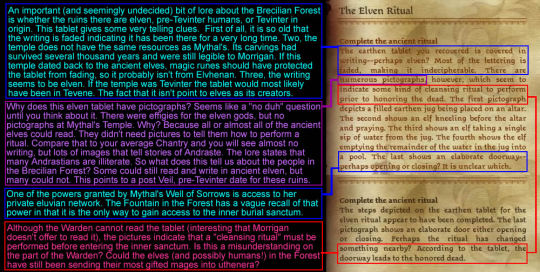
The quest text says that the warden uses a series of pictographs, rather than the elven writing, to figure out how to open the uthenera chamber. This suggests the text dates from a later date than Mythal’s temple because the who worshipped there did not need pictographs. They could read elven. How long does it take to forget your own written language?
In the real world, the Maya seem to have lost their ability to read and write in their language in about a century. The combination of the Spanish invasion of their homeland, the wars that followed, along with the diseases brought from Europe were a devastating combination. The Spanish burning Mayan codices and (if I remember correctly) wiping out the Mayan priests along with their religion didn’t help the situation.
This seems roughly analogous with what we see in the elvhen empire. The wars between the elves along with the quickening could have taken a toll on the ancient elves ability to read and write in elven. It probably was a slower loss, but it might explain why the tablet is half in script and half in pictographs.
Of course, the pictographs were for the benefit of the ignorant humans moving into the region, who probably couldn’t read or write elven. There doesn’t seem to be, however, any humans pictured on the tablet so it doesn’t seem likely that they were the primary audience for the tablet.
One final thought on this point: Is the Warden under a compulsion or geas to one of the Evanuris if they drank from the well? And, honestly, there is no way to say yes or no at this point. There is no sign that the Warden is hearing voices like Morrigan or the Inquisitor does, but there does seem to be some mild compulsions associated with the ritual leading up to the Fountain. We don’t know whether the Fountain would have given the warden access to the eluvians that were probably still in that temple when the Fountain last was fully functional. Drinking from the Fountain does give the Warden access to the inner burial chamber, which is reminiscent of Mythal’s Well.
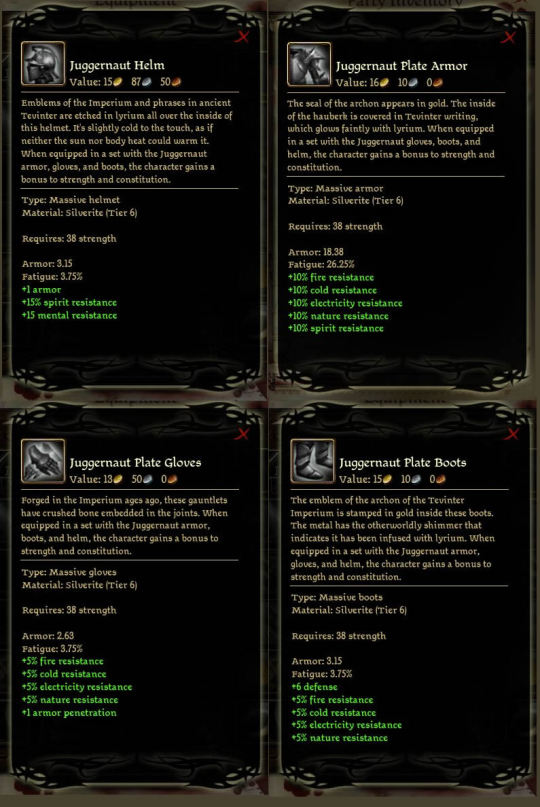
Given the fact that the elves, the Clayne, and Tevinter fought for control of the Brecilian Forest and the last Revenant and piece of the Juggernaut armor associated with the mage’s treasure quest is found in the burial chamber...it is possible the Fountain had already lost its knowledge and there were not enough elves who knew about the ritual to carry on with it after Tevinter was driven from the forest.

Tevinter had to fight the elves and the Clayne “inch by inch...using terrible magic” to take over the Brecilian Forest. This is reminiscent of the story the elf in the spirit stone tells the Warden, yet we have no proof of whether the temple had already been despoiled in earlier conflicts or if Magister Harach or another Tevinter took the knowledge of the Well.
I also wonder if the Fountain was merely the gateway to the real Well on the inside of the chamber. The tablet said that the elf with vallaslin stood in ‘water’ that was waste deep, and it would be pretty difficult to do that in the little puddle in the outer chamber. Perhaps the real Well was actually the large, misty pool in the inner chamber. All that seems certain is that there was not enough knowledge left in the Fountain to be noticeable to the Warden.
Geas-y Wardens?
So is the Warden under a geas? Even without the knowledge of the Fountain, there may be enough of a compulsion on the Well that the Warden could be in trouble if the Evanuris to whom the Fountain was dedicated is released from the Fade. We have several possibilities as to who that might be. Elgar’nan is all over the room and Andruil along with Sylaise can be seen in the alcoves.
But there is one interesting and almost hidden figure in the room worth mentioning. Look closely at the altar where the water from the Fountain is empowered (or whatever happens to it). There is a symbol for another Evanuris on it.
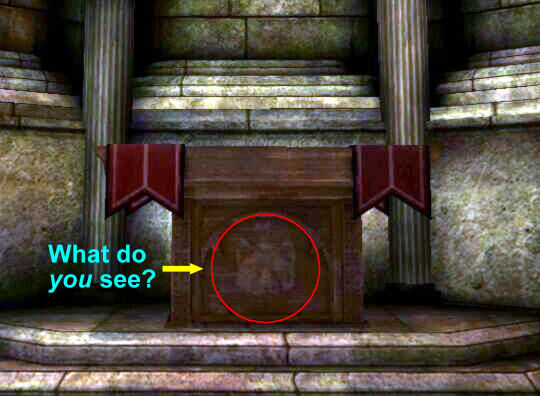
Looks like a bear to me, a symbol for Dirthamen. Could lead to interesting things....
-MM
Think you missed part of the “Well Shit” series? Here are our previous posts:
Part 1: Searching for the Secrets of the Elvhen Gods
Part 2: Origins of the Vir'abelasan
Part 3: Dirth of Knowledge
Part 4: The Elvhen Ritual.
#dragon age#dragon age origins#brecilian forest#Brecilian forest ruins#vir'abelasan#Well of Sorrows#mythal#dirthamen#Elgar'nan#andruil#sylaise#evanuris#elvhenan#dragon age ancient humans#uthenera#dragon age meta#dragon age theories#morta's musings#long post#thanks for reading#life kicked me in the head three weeks ago#took a lot longer than I would have liked to finish this post
138 notes
·
View notes
Text
Call Metaphysical Healing Shop Hawaii For Amazing Offers
By Pamela Clark
Plenty of people are interested in crystals nowadays, and it is not just because they are so pretty when you wear them as adornments and accessories in the many forms of jewelry that they are available in. These natural beauties are also very useful and have a lot of purposes when you want to heal and empower yourself. By shopping for crystals at a metaphysical healing shop Hawaii, you can have something that both looks good and works well. Anyone can hear some enlightening information if you step into one of these shops and talk to the owners and some of the employees there. They will usually have a lot of information to give to you. There are a lot of exciting historical examples of crystal use, so you will not be bored. Myths are one way that certain lessons have been taught to us in a way that we can understand. Although they are called myths for a reason, you can still learn a lot about truth, life, and the universe from these stories. In fact, a lot of people's use of crystals has some origins in these stories. The fashions of us modern mortal humans is much different than the fashion trends of the ancient Gods. Since breastplates were common for them, as they were often warring with some god or another, they would often wear their power crystals safely embedded inside of these pieces of armor. If you do not regularly wear a breastplate, though, you will still have ways of wearing these things. Priests of any religion are often the ones who are responsible for holding on to all the precious knowledge that has been passed to them, and to keep it passing down through the generations so it will not be lost. Sometimes it is hard to remember everything or know exactly what to do, and sometimes it helps to have a helpful message that might tell you about the future. That is what crystals do for a lot of these priests. A lot of people have heard of the legend of Atlantis. While the only official historical record comes from Plato thousands of years ago, people now know that crystals were a part of the Atlantean's society. Among the things they used them for wearing communication, to heal, to keep records, and even to control the weather. If a person is asked to think about the Mayans, he or she is likely to come up with images of their unique form of pyramids and their majestic statues. Some people have even been to these historic sites and seen them for themselves. These individuals might know how important crystals were to these people just as they still are to many today, and they used them in their architecture. The Mayans were a people of old who used crystals a lot in their sacred practices. An example of this is when they would use these beautiful natural objects to make altars and pedestals. These crystals, which would refract light and give special messages in the form of visions to the priest, were valuable tools for these people and much more than just a pretty thing.
About the Author:
Get a list of the factors to consider when picking a metaphysical healing shop Hawaii Kailua-Kona area and more information about a reputable shop at http://ift.tt/2uM7mdK now.
from Blogger http://ift.tt/2fQkSeB via Call Metaphysical Healing Shop Hawaii For Amazing Offers
0 notes
Text
Incense Correspondence Table

Written and Compiled by George Knowles
Incense has long had associations with magick and witchcraft, as indeed it is used commonly by many other religions. The use of Incense in witchcraft is threefold:
(1) It conditions the mind by stimulating our senses of smell.
(2) In connection with spells, it draws down the spirits through it's magickal association with the elements of Air.
(3) According to ancient beliefs, when a spell is done. It raises the spell up into the ether and sends it on it's way.
In magick, the type of incense used needs to correspond with the nature of the spell being worked. Most spells require an incense associated with a particular planet or deity. Many are used for their purification and cleansing properties during ritual.
Below is a list of commonly used incenses and their corresponding associations. For other associations and correspondences see:
Blue Berry - Burn this to keep unwanted influences away from your home and property.
Blue Roses - Is specially crafted to honour the Goddess in all her aspects.
Carnations - This is a sweet floral scent traditionally used for healing.
Cherry - Is sacred to Venus, this blend will attract and stimulate love.
Cinnamon -Is used to gain wealth and success.
Coconut - Burn this for protection and purification.
Copal - Is sacred to the Mayan and Aztecs, this blend is suitable for honoring the Gods.
Frangipani - Burn this to brighten your home with friendship and love.
Frankincense - Use this to draw upon the energy of the sun to create sacred space, consecrate objects, and stimulate positive vibrations.
Honeysuckle - Burn this for good health, luck, and psychic power.
Jasmine - Is used for luck in general, especially in matters relating to love.
Lotus - Is used for inner peace and outer harmony, to aid in meditation and open the mind's eye.
Musk - Burn this for courage and vitality, or to heighten sensual passion.
Myrrh - This is ancient incense for protection, healing, purification and spirituality.
Passionflower - Is used for peace of mind, this sweet scent will soothe troubles and aid in sleep problems.
Patchouli - Is an earthy scent used in money and attraction spells.
Pine - Burn this for strength, and to reverse negative energies.
Rose - Is used for love magic, and to return calm energies to the home.
Sandalwood - Is a delicious all-purpose scent used to heal and protect, also for purification.
Spice - Is a fiery scent and used for any magic workings.
Spirit - Use this to raise your personal vibration, attract spirit guides and honour your personal deity.
Strawberry - Is used for love, luck and friendship.
Tangerine - A solar aroma used to attract prosperity.
Temple - Devotional incense used on the altar during ritual.
Vanilla - Is used to stimulate amorous appetites and enhance memory.
Sources:
Books:
Encyclopedia of Wicca & Witchcraft - By Raven Grimassi
E-mail:
Sarah Nunn - The Swamp Witch of Elven Coven
Website:
Cerridwen's Retreat - http://www.angelfire.com/ky2/cerridwen/index.html
https://www.controverscial.com/Incense%20Correspondence%20Table.htm
0 notes
Photo

Corn Magick
Published October 1, 2016 | By shirleytwofeathers
Scientific name: Zea Mays. Common names: Indian Corn, Maize, Squaw Corn Type: Vegetable Ruler: Sun, Aztec and Mayan deities, Earth Mother Planet: Venus and Saturn Element: Earth Magickal Form: On or off the cob, popped, white, yellow, blue, red Parts used: Seeds, silk, husks Magickal Properties: Fertility, Protection, Luck, Divination, Prosperity
Corn can be used for spells protection, luck, and in divination. Corn on the altar represents the power of the Corn Mother, She who blesses and nourishes all Her earthly children. Corn on the cob represents the phallic gods and draws creative or sexual energy.
Often Corn husks and Wheat straw are used to create what are called ‘Corn Dollies’. These are usually in the shape of a doll or are woven into various other shapes and are carried as charms or put on an altar. Corn dollies can be hung from the rafters of a house to offer protection for the house and all those who dwell within. Corn can also be used in many forms of fertility magic. Corn silk is a very powerful ingredient when added to love spells; it is designed to attract the person you desire.
Corn can be worn as jewellery or in amulets to make the wearer closer to the spirit of the earth. Corn can be used to divine the future. An old folk spell said that if a damsel found a blood-red ear of maize, she would have a suitor before the year was out. Financial or love wishes that are shouted out as popcorn is popping will come true.
Eat yellow corn on the summer solstice (June 21) for blessings of prosperity
Consume white corn for spiritual insight
Scatter blue corn meal to purify and bless a space
Hang red corn above doorways at harvest time to protect rewards that have been reaped
Corn is a sacred Druidic herb of Mean Fomhair (also called Mabon) and of Samhain. Corn is associated with the element of earth and the planets Venus and Saturn. Because Corn was such an important part of the food supply of many early cultures, almost every ancient religion had a Corn God or Goddess.
Some of these Corn deities are: Annonaria, Roman Goddess protector of the Corn supplies; Cerklicing, the Latvian god of fields and Corn; Kurke, the Prussian God of Corn; Nepit, an Egyptian Corn Goddess and Neper an Egyptian Corn-God; Nodutus, the Roman god who was held responsible for making the knots in the stalks of Corn; Nzeanzo, the Sudan god of rain, medicine, Corn, fertility and metal-working; Robigo, a Roman Goddess of Corn; Iyatiku, the Pueblo Corn Goddess; and Gabjauja, the Lithuanian Goddess of Corn (with the advent of Christianity She was, as were so many other Pagan deities, reduced to a demon).
Important note: Remember that when harvesting Corn for magickal uses it is important to say thank you to the grain spirits:
“Mother of Corn I harvest thee. In spring thou wilt A maiden be.”
Collected from various sources, including Magickal Winds
https://shirleytwofeathers.com/The_Blog/magickal-ingredients/corn/
0 notes